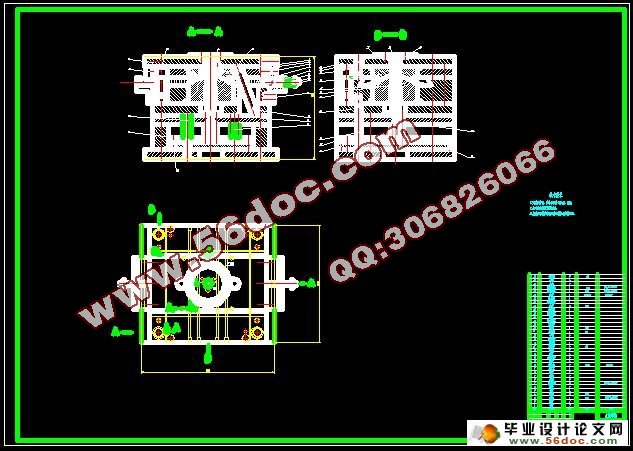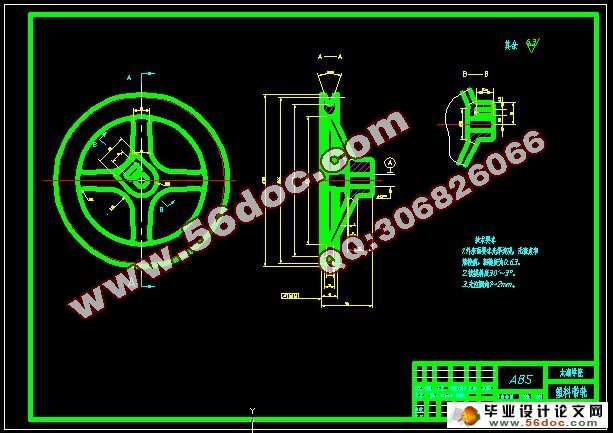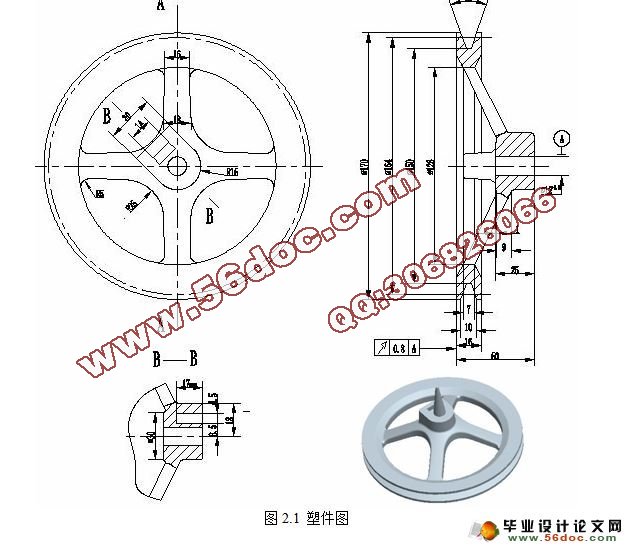塑料带轮模流分析及模具设计
无需注册登录,支付后按照提示操作即可获取该资料.
塑料带轮模流分析及模具设计(任务书,开题报告,外文翻译,进度计划表,论文说明书17000字,cad图纸6张)
摘 要
塑料工业是当今世界上增长最快的工业门类之一,而注射模具是其中发展较快的种类。塑料注射成型模具的特点是:能一次成型外形复杂、尺寸精密的塑料制品,对各种塑料的适应性强,成型周期短,生产效率高,产品质量稳定,易于实现生产自动化。因此,应用计算机辅助塑料模具设计,对缩短模具设计时间,提高塑料制品质量和生产效率有很大意义。
本设计主要针对塑料带轮零件,应用计算机辅助模具设计。设计中首先根据塑料制品要求拟定成型工艺方案、初选成型设备、确定模具结构方案,设计浇注系统并进行模流分析、选用模架、选择和校核注射机,完成模具型腔设计并对模具主要零件设计计算,然后应用PRO/E软件,完成整副模具的三维设计,并对模具进行了虚拟装配和试模,针对其中出现的问题,对模具进行了修改,最后导出模具二维工程图。
关键词:塑料制品;注射模具;计算机辅助设计;PRO/E
Abstract
The plastics industry is the fastest growing in the world today one of the industry categories, the injection mold is one of the rapid development of the species. The characteristics of the plastic injection mold: Can forming a complex shape, size, precision plastic products, adaptability of various plastic, molding cycle is short, high production efficiency, product quality and stability, easy to implement production automation. Therefore, the application of computer-aided plastic mold design, reduce mold design time, improve quality and production efficiency of plastic products.
The design is mainly for plastic pulley parts, computer aided mold design. Design prepared according to the requirements of the plastic products molding process solutions primaries molding equipment, mold structure of the program is determined, the design of gating system and mold flow analysis, selection of mold, select and check injection machine, complete mold cavity design and moldThe main parts of the design calculations, And then apply the PRO / E software, to complete the entire pair of three-dimensional mold design, mold virtual assembly and test mode, problems for which the mold has been modified, and finally export mold two-dimensional drawings.
The design, injection mold design has a more comprehensive understanding, deepen the understanding of the mold structure and working principle and to understanding mold design should pay attention to some of the specific details, learned how to access and data collection methods; Societyhow to apply PRO / E software, to complete the design of injection mold, thereby effectively improving the efficiency of the design.
Keywords: Plastic products; injection mold; computer-aided design; PRO / E




目 录
摘 要 III
Abstract IV
目 录 V
1 绪论 1
1.1塑料工业的发展及用途 1
1.2塑料模具在塑料制品生产中地位 1
1.3本文主要研究内容 2
2 塑件成型工艺分析 3
2.1 概述 3
2.2 零件的材料和注塑工艺 3
2.2.1 材料ABS 3
2.2.2 注射成型工艺分析 3
2.3 确定模具温度及冷却方式 4
2.4 零件的三维图和二维图 4
2.5 带轮的结构与精度分析 5
2.6 塑料制品的几何形状 5
2.7 注射机的选择 5
2.7 零件图及其尺寸公差 6
3 模具总体结构设计及零部件的设计 7
3.1 型腔数目的确定 7
3.2 分型面的设计 7
3.3 浇注系统的设计 8
3.3.1 主流道 8
3.3.2 分流道 9
3.3.3 浇口 10
3.4 冷却及排气系统设计 10
3.4.1 排气系统的设计 10
3.4.2 冷却系统的设计 10
3.5影响塑件尺寸精度的因素 10
3.6模具零件工作尺寸的计算 11
3.7 凹模底板厚的确定 12
4 合模导向机构的设计 13
4.1 导向机构的总体设计 13
4.2 导柱设计 13
4.3 导套设计 13
4.4 推板导柱与导套设计 14
5 脱模推出机构的设计 15
5.1 脱模推出机构的设计原则 15
5.2推管推出机构 15
5.3推出机构的导向与复位 16
6 侧向分型与抽芯机构的设计 17
6.1侧向分型与抽芯机构的工作原理 17
6.2抽芯距和抽芯力的计算 17
6.3斜导柱侧向分型与抽芯机构 18
6.4 侧向分型与抽芯机构尺寸计算 21
7 利用Pro/E进行分模 23
7.1 创建模具模型 23
7.2 选择模架 26
7.3 创建分型面 27
7.4 分割工件获取成型零件 28
7.5 创建浇注系统 29
7.6 铸模及模流分析 29
7.6.1 模架概述 31
7.6.2 模架的分类 31
7.6.3 模架的选择 31
8 注塑机的校核 33
8.1 锁模力的校核 33
8.4 最大注射压力的校核 33
8.5 开模行程的校核 34
9结论与展望 35
9.1结论 35
9.2不足之处及未来展望 35
致 谢 36
参考文献 38
